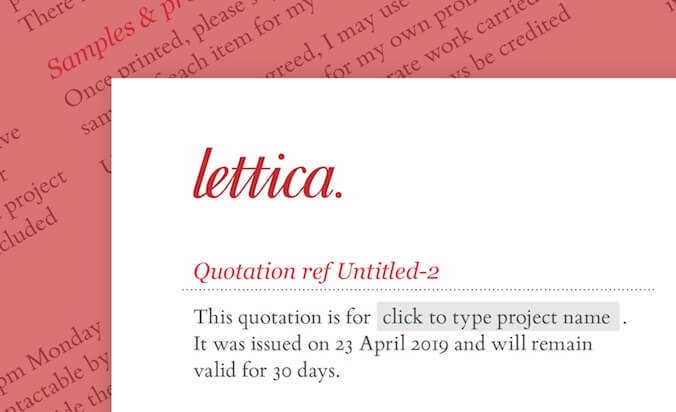
How useful are templates?
Friday 26 April 2019
Templates make it quicker and easier for me to produce simple documents like quotations.

Friday 26 April 2019
Templates make it quicker and easier for me to produce simple documents like quotations.
Templates are all about saving time and effort, making it quicker and easier to create documents that look smart and professional. They dangle the possibility of creating your own correctly-branded eye-catching materials without having to pay a professional designer every time. I can see why they are popular.
But they are not failsafe.
I use templates for things like quotes, invoices, and letters. They undoubtedly make it easier for me to produce these documents quickly and I’ve yet to encounter a problem with using them. I just fill in the name, contact details, project information, costs and so on.
I even work with templates of sorts when producing complex, designed documents like brochures. These tend to be collections of type styles, colour palettes and layouts which I can use as a starting point for a new project for the same client.
These two examples illustrate the two main variables which affect whether or not a template will be successful in delivering the quick and easy pathway to good-looking documents that they promise: the content you want to include and the amount of user input required to use a template successfully.
Templates are most successful when the content you want to present is very standard in length and nature. This makes it both easier to design the template in the first place, and for the end user to achieve the intended outcome with it.
Some sorts of content have a very standard structure, so a template works really well. A letter, for example, will almost always have two addresses, the date, a salutation, some paragraphs of text, and a sign off at the end. It might also have a subject line. It doesn’t really matter how long the letter is because convention says that it’s ok for a letter to just flow onto another page once it fills up the first page.
The user simply inputs the content and applies a series of paragraph styles as appropriate (Read my blog post for more information about how to use paragraph styles).
But if the content you need to present is likely to vary in nature and/or length then a template probably won’t be as successful because there will be too many occasions when the container simply doesn’t fit the content in terms of size or layout.
Some templates still require the user to make fairly important design decisions. PowerPoint templates are a good example of this. They normally comprise a range of title slides and content slides, combined with a palette of colours and some type styles. It’s not unusual to find a standard footer on each slide. But these things can only take you so far towards producing an effective PowerPoint presentation. It’s just too easy to produce a terrible end result from even a very well-designed and thought-out template.
The most common pitfall is putting too much content on each slide. Powerpoint will also, very unhelpfully, resize your text* to fit your slide, making the text smaller and smaller to allow you to fit in everything you want to say. I say ‘unhelpfully’ since reducing the type size until all the words fit is almost the worst solution to the problem.
A better solution might be to shift some information to the handout, edit the information you display on the slide, or add in more slides. A designer would almost certainly do one of these things before shrinking the type size. Why? Because the size of the text will have been chosen specifically to suit the environment in which it is intended to be used – at a distance, possibly in low light, or with low contrast. It will also look significantly less professional if the text on each slide is a different size, or if the content almost hangs off the bottom of the slide.
PowerPoint templates are relatively simple but templates can be far more involved than this. Generally, the more complex a template is, the more skill it requires to end up with a good result.
Templates are, by definition, designed before the content is written. This may be ok for a letter where the content is very standard in format. But in other situations, this raises questions about the value of designs produced using templates. How can the designer possibly know how best to present information they have never seen and are never likely to see? And how can the user then best use that template to communicate a message which doesn't fit into it?
Good design works the other way around – looking at the exact length and nature of the content, and then finding the most effective way to present it in order to achieve a particular goal. That might mean highlighting the most important thing, telling a particular story or getting people to take a particular action. You can read more about this in my blog post Form follows function.
It may be possible to create templates for more ‘designed’ items. But keeping the layouts flexible enough to work with a variety of content will mean simplifying the design and potentially compromising the usability and/or effectiveness of the finished documents.
* It is possible to switch the AutoFit feature off, although it relies on the user knowing how to do this, and choosing to do it.
Recent posts
Featured posts

Hello! I’m Sarah, an independent typographic designer, helping businesses to communicate their unique selling points through printed marketing and communications.
I’ve been sharing my knowledge about design, typography, marketing, branding and printing since 2014. I hope you enjoy reading my blog.

Sarah Cowan